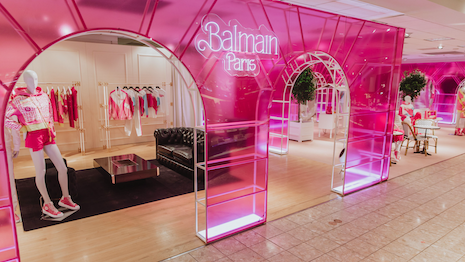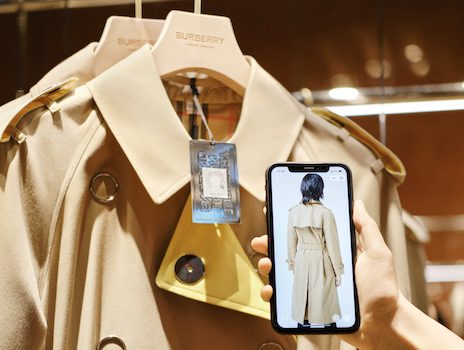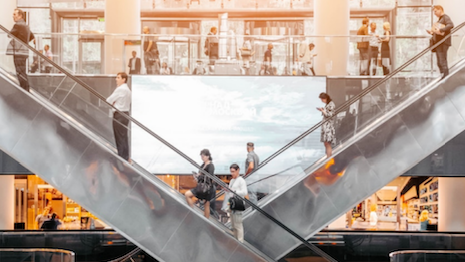Despite the tumultuous effects of the COVID-19 pandemic on retail, shopping malls have persevered and are transforming to match new consumer behavior.
According to Placer.ai, consumer behavior indicates that shopping behavior is stabilizing and, likely due to pent-up demand over the last two years, people are returning to malls. To set themselves apart, mall operators have had to creatively fill open spaces left by store closures, such as pop-up shops and art installations, as well as meet demand for digital touchpoints.
"The future of the shopping mall is centered around two core pillars: a more diverse and interesting tenant mix and a greater emphasis on flexibility," said Ethan Chernofsky, vice president of marketing at Placer.ai, Israel.
"Yet the most powerful aspect here may be the fact that, as malls move in this direction, a greater level of diversity is created reducing the direct competition between malls and creating a potentially bigger pie for the wider space to enjoy."
Key insights
At the beginning of 2021, indoor malls and open-air shopping centers trailed outlet malls, but by the second half of the year, they started to see similar foot traffic trends. By October, all three mall segments exhibited year-over-year growth.
The holiday shopping season typically drives a significant portion of foot traffic, but the surge in Omicron cases and supply chain shortages caused a dip in visits around Black Friday. December saw visits starting to climb, though, nearing 2019 levels.
While they are on the road to recovery, with higher-than-usual vacancy rates leftover from the pandemic, shopping centers must innovate and implement new strategies for attracting and retaining consumers.
 A Neiman Marcus Balmain x Barbie pop-up took inspiration from Balmain’s home in Paris. Image courtesy of Neiman Marcus
A Neiman Marcus Balmain x Barbie pop-up took inspiration from Balmain’s home in Paris. Image courtesy of Neiman Marcus
Pop-up stores and temporary art displays have become popular solutions to filling the open spaces, and data shows they are driving mall visits.
Last month, U.S. retailer Neiman Marcus launched an exclusive pop-up experience celebrating the Balmain x Barbie collaboration in partnership with the French fashion label at the retailer’s NorthPark location in Dallas, Texas.
The space took inspiration from the glass pavilion of Paris’ iconic Grand Palais, adding a dose of bright pink, with park benches and other French motifs. For weekend activations, Neiman Marcus played up the experience with live DJ sets, a cotton candy machine and photo opportunities with a life-sized Barbie doll box (see story).
Like businesses, consumer sentiments are still evolving and shoppers are hopeful for a post-pandemic world.
Waves of different COVID-19 variants and supply chain issues have led to constant changes in consumer behavior, including visit length, distance traveled and customer loyalty. For instance, in Q4 2021, visits were shorter than they were pre-pandemic.
While some elements of behavior are beginning to solidify, others remain dynamic, underlining the importance of adaptability and agility on behalf of shopping malls.
Part of adapting is the move to more digital components in the shopping mall experience. Placer.ai suggests digital data can provide crucial insight, and malls should take advantage of existing data of online behavior to incorporate into the physical space.
Digital physical retail
With the growing consumer demand for convenience through digital processes, both in stores and online, retailers have been automating a number of touchpoints.
 Scanning QR code on Burberry's classic trench coat in the Shenzhen, China social retail store. Image courtesy of Burberry
Scanning QR code on Burberry's classic trench coat in the Shenzhen, China social retail store. Image courtesy of Burberry
In 2020, tech-savvy British fashion brand Burberry opened the luxury sector’s first social retail store in Chinese tech hub Shenzhen, binding the physical and social worlds in a digitally immersive retail embrace.
The store, backed by Tencent technology in an exclusive partnership, opened in the Shenzhen Bay MixC development, designed as a venue for exploration, inspiration and entertainment, letting shoppers experience Burberry and its products in person and on social media (see story).
More recently, tech giant Amazon announced a new physical fashion concept store as it hopes to transform the in-person shopping experience. As a retail behemoth, it just might.
From personalized shopping to innovative fitting room experiences, Amazon wants to integrate the benefits of shopping online into the physical environment. While the company did not disclose a specific launch date, Amazon Style will open later this year at the Americana at Brand retail complex in Los Angeles.
At the core of the physical fashion shopping concept is a new, seamless way to discover products. By using the Amazon Shopping app, customers scan an item’s QR code to view size and color options, customer ratings and additional product details.
They can add their selected item to a fitting room, or send it directly to the pickup counter (see story).
"For luxury retailers, the key is to adopt technology and innovation in a way that enhances the luxury experience," Mr. Chernofsky said. "Appointment shopping is an amazing way to improve the likelihood of conversions while giving the customer a unique and exciting experience, all while better utilizing off-peak hours.
"Focusing on loyalty and personalization will also be key as the shopper increasingly expects the brand to invest in the customer relationship," he said. "Yet, the key is to ensure that the emphasis is on enhancing the luxury experience and not simply replicating an idea that succeeded in a parallel space."
{"ct":"7tIYJHaPT8bF+ONsJu8y5saQoMtW++Tpb6xLTsUr6OQRTUj9uKXbD+8WBbeXEuc2F3itb8nHygg+n4uV8896ZRY6EOWPJSmYyhvl7arW972uJelPVQaSeVwkO9RhExZGWXrbUc7eNOn\/uBy6g+eYRRmPLUntjDRKISSJzYregRFKPmE7jq5X2k0i5Xh8hAZJoE848+8dvWWDhWiGpT1QwbGt56z9IQ0YOvV1kxFtCW\/eRlbitvV9OBYmw4LZ+tFLmz+OxxxQeI6PY4+klmHgAeKFNTEpCTLkiJXqxpany7djxsszYh6t8ntb1QkFEXB+nTdWUfRwKjNTnFQ2n6I9lTjm7lR9IkZEewmc8JSPpktbFU+eGghqZ3MQLmhdCpuobmF5d1usnhYeq7iOGVYJpN7Pbvc+sT3ws3Z7KnS6DewXt3fB5tLnLIh5FXI2kWy\/fdIS+GXOf3d+u6yN+oMX6wpOF7LJ+kjO3ykjubVVw0COH20cJvFG\/\/jGogEUT+8jtH3ra7TRGTe8qTg\/+OrvopCWEBrWK\/gUVNgqd24rwGl1qecooWgiXGYZnnvhMUuTHcY0Ex8D\/MW18WqmKjsUH0M4UJ5RcteGrk8GRn5iN6HLi9nMQ7ah0izuj9UU6nMhP0iqsWhOqfhFfzv7OCMXZAhpgGqWsN1Q+Kmpu5vjJgt6SxdoO7O7\/uZJNl2fX3w7QU2KA5dc4CjpSQg7ET7qw5hz+n53eTnZsHKT1S08KJVfzPlKbwhWaNrTHoWnp7tUE+7QR4oYHXCsQO\/9JDI+I85G\/XS0Kww\/SKHQxxERC3ynGAmTX9UBwpxd6AJTaJ+hhOzTYj9spqp6emygZE8WABYpLTTcVGqh90OjoaYpadQI\/UEfXd5s8G7tH7iMZkljGO2qEf+L25QjMFSlCzLs5lTaZCnGJUXuHxcp+1VJM8UwsdoEimcCyYBiE5tOkO9LMyiVr++KD68WuJjFPgBv\/suMSZloEdpV7D8fcUeZ+FLeq+U2OAkcKY0uYUL\/\/mljEaqrvt1nBhBBoj4krBgvKRu9VTkQEkAbvJKVe+Xv5n+JYF+LBApHcp9AlQ0eqdWC42Su2jQeIOaPza9jV8ocqnMFelQeIrPDppe9C8MU18g8vQ\/Zy8jw6poA+IqTsts7SztMNjQacbwGQybTHy27FYv5\/dLE1NgaPPjp7Ajk+phdu8te9kraMzWrnDfRatSzOur\/8mu+FzGYlKXoyXeVWhWJrNZdsdb2SUsb9PfnjIKGc23Ue7lmx0EhHPi5LI24kQgEB2WhUK78JU4T9EwAP29HLe4oMV8Ekr\/R\/cb+1y1cWHGIeh7X5kcjvDMJhX0h30nd2NKx2qdsKOQgHrlQNogkB+Q20\/Itk4YXEsjoV7ad13XSNKRL2+Fknp0gYOQhcKCCiXS1xDFkV6GM67cpoHHirRqz\/jhkwXr7hm4MFKjoRQk6WZwRwQIgXwpBzG0QzKjF\/wzYNHEftNGoCwEimSNdE7q+hX\/VPg1tRr2fvWQAMaZR2gw6vxSatRZdBp459Q6OCxC99yVkwg9xWt0Xe5jL9yWebJxtN8Fnk+6venlShypXzY7L23nth\/CztpAcnzKBfhK1hLQ69dHWD6hixOQfzX79bjAWStQtdpDOP5OheywzSA+e+4FbqTVmN1oHJ0mmqvalnVW6IfYDendysQjtgkVRKx72Pm8mRtYe5g8aTPgAjnl1ltw5VwxMclzLUeUyElaHvmVvx3IQHe7uFgLQC3OQmhY6CtSaRPiFEXoNtPJns6W8EB\/lK\/yqig1ZCqEjl\/4ogsMdgE7t9JNjTZCkEl663vBOyN\/TY0g317ywHtG59rNlAYK5SgFusECnzmTTf2SL7uzDF7eEoDADXYUfj\/VJ3pUa+Pg7fZlKzICoVwcpnmuKQdEm4MV3DqoNhiUjn5RrVMGsaEfmV2HCx9Sen40\/QCWpYu\/PDXfREcCWf29N+Q5RIi8wffddcyUuI\/Fd0dFBoVVJK0nYfRFkoxqeMmCMYOuY2AbTS+K8RVwQY9zTwOMlkD3LvIMrVbXnUbVuC0rsf170JEbFno\/idj4joRxEOVzhNUIEskvlpJYJAqLeb4suVYTU8NqFIZ3tnAjbAXjb6DJt\/bJ0KtIRCKvSYFIK6D\/i1bNLSDhNRPVy\/ICtlqLGIv6AJurR\/4g2FEi35gAQjWYDMj24h+rRsHwEFAgB+0V3fW4KUab3Wrgw6ZGvdMGJdrejERyHp\/YYvnXEA18ehPlIM8sd3Q1p4b4n2hD8AZVYF2O9TqUbjnZ8bOYFM5TbCOyJWpDY0rzcC0h62M5tRukOMAezsNWu0Ei8lK30nOi6PBRzPQ78NwRtU0IZPbFL4yfBYu\/2KlFpjtmTQIhCxjDaz1BEqMAKi16slowW+ZlPxUKaqs3+mVnzy93vP5FjTezHf5QpRaiPrdyNSDUNLcLehZaJKiw\/8G2kjNFTrE+6OtkgWe3Bz7NHtYTggFh56WZ52L2JFS2bv2IfCEGTkKv1CUk\/F0pvNxluuiUB+QbOaurXmbHq7cXDQ7JrwLkDyBolGZiMCAwTetQzdTdI5AecFgqRMOhuQqORIeWKxyV++GaQN\/tci1duccYf6Y\/a3JO\/BnkjIRwtfcfyzBk8zsXMlDCoc+cMI9ULQNzQVYxRcSF00NV56a9+4bXm1mssU3x8Cj\/6JRZlEtDqtdnyzP3uMunnYzG5BDI3SCJPlG8tTt7LqtmFz84mh\/T5zLvZYaIeLjmHTLeKHaA7ubvttnXlZS304b5eImczKS+XFRY0nBOXGYUseGX5VASyD\/645lXYWajZQ822gsJ5NNx1V0wamFvYrIfruG8qIcuoVRSrlVmfsEMbOuzgnHLX7hKQqaj0XmrvwjFuz17PBNtGv2Ex8mSzvsOHtrvpbpJDYNTZBy9Yh5sHyFl1KeXnuPLV9OZhIUmQfHLBgKYY9Z04HW7DI7nGt8tKEg9jb0CIuBdnK+dPTxPAnPZSfVY0Jrt7\/bpIVRRr+c1aFsHdtPS5HLBRVRJ+aN3FeeFrKtjAUUEk6MbnVf2crqZwTZb\/121u33dA\/W22DSPZxfOq2xMxCzoeHvyjg7yQKhgKDWLbrs5OIyhnSpUkmg4\/ZrsRzcQ0BB2X04W\/tWMzGgamBuznc3ySx9wyBY46+k0yIj4UdXVrAZSAuRgAn2cQIVbrHNjqgki09p1dqyybTzQornnX+1PBa2QeOGxY8mzdjLrPPZ\/H8kk20yWdYWUQqDXe4tszL8vi6iDmkFE\/tSTcGn+r6MkYVrgMFxopLoW26EwmWGtazBG+nukRjPiRQM0TR4nDFVaO1dzWX2J2qr9WmJPIg1zMpeO90saEMTIWZsHjBM38BHd6\/KM\/dO7ZlhlscMVAzbLDQCSt1Zu\/IFwua9sfvnkrvSMRbpTVnANgoRcGetp8bp8kUGgaQdoPhyNL\/79zZpTTYDzIhHwhrbLoLGG7k7GnlU4JGhcOKlmuTkapIY5lZcdZT\/K+0HYcbtf+200SLkdmqkSUsUC8NAgHSsxZQLOdpqm5UBLtcmKc646CIT1igaETDbafWjc8qo7FdV8lCGl1ambZ7O3swhAPzZWzNZkkoKey5ay+pNaj0gTu4bags7yP0TJlgZSr9ivoGiv8J9At3PR4+zUdlIanaC\/Ut+2l1zdJuCoONnVfitbewJ26hOcPNWGACZG5U3QEwBZTcwUIIl3sFsfDAph1IWpRd+WnbazTXsSK8oMCJljznJ4KVFMaRESPrKhs+dT6ealG5bl35aClvYHu3MVGxiBQ+T0I9XqUeMLZOpBUCaLT8FukoSEnqp6POb3nCLkVO8J2hTWI8d3vn\/6F6MV+6BbGLD57ODpb+mPYvQ3pEvuK9J2epsbRZzwz4JO7y0ykWBhSmcpFeBKMvuALInFK26t\/S4KormLd3vsaDcFivn0QVamO8z0g1G937BsA+wB66ztSfvb2X0I+ys0jvz0wjnphAJbT1PhhC4WrHARys6n+ulHT6CmOpe\/mGDBNhvYAtXtXRwIe4jBdJa\/H\/h\/ukqszKtPmHvn60EOQyLMgbWFWb3FP3LBEri6MIclW9NzHZk1iOCcX9hbcyRvxcc2FAWRWMHYj1j+gkd64nrIQh3S+0iVboiD0t3vquMmb8l0jq85D7pX8YcpoRgWViRB0aT6hqAXfNzcRvAdlQpN+yb7aYhseoONGBwX3Yp9p3PdESPtul3P0gjDQ8PpSeFGA7H61DbQTeMW7HModOLzf4mpRkeCLu51c0qMFOfWfbiQH558t7gT48evIoit6Bw50EcyWtoROwYM4wNMOqyu5yOi5artuPhC40ZE8b\/7pxtqCGa6q5FgJRsaG4B8D6QgkoxaFyhAvXX7w9WfqizRLZG7\/RQk8+fHDd8QOR\/uz25kq55iShXU9+T70niBexEQRdHpOQxUO2Grb27cE5qkqvOY79HzEsZxdFH2vLBe7cSJcIys0zWET0X2oc6rHYZD\/kjGSxq3x3anixGTvbR5J4Sp9Yakcx7wtG0DeOobzol7wFvzcD3DbFLXaWURcNeJgGPYr0WtOlzbpjrWUCtT90I98OR3pzfo8ZfAxi9\/tVn26dJZcKCLsWzZUe6z3dmzLHm\/+coYlkVze+wUKrvdka7oukF3JehJfnouUoxhJmKj\/AJvONOSktxuvwp+I0aY8DIj9mfL0nfbRTxTZpKNsXkvCE99JmbW2X9FK3TRy3JshN1rfIsv2Ne0xm5QYZafI6XEJ+APUwU0Jm152gXL5nrZoAY+CeEorplPlJLB8k+7Q\/5ATRJ2lhnINEHt5XwHfmDTy5nOd9Q2B26+AVmyKuw1d\/UbthwaDpe58eUPLrETUcpnmx8sBdxOjiUVUMnNTSbAUre9yTWf2qQxto8Id8W2wjW0Zg8TBf2Bmc8nyVb2KVaaJqv99Mf7yxcxsQBGQYCYLTYIYracsTEP2V+cH9\/lfaTYWD\/W02AfoP+BRE1bcEY7wPX9PYMuwaj1Tz5edq2pgXqYz+w5md6QbuC+a87N+1WMgxzROvOae\/ObZfjQhUDaqXPbCeKG0DnnS2HfxSkUyNg6SW3tDZ9hSUssh9Hnj5jcUkUwh2FwZ\/YYmvjSKk0unEYKXd3iVlGRbjrV6shWQ7vxF8lLessjzMaNrpGOYezzfyyjuX3qEjRyirWIYIMaPQpcqqYdSLWipOY+WoZ3OyMNgh3wkA4O1Df56gJ4t9Qr0fMNTi7Yhfj63eJXC+VpenxcSeACz7rHmB1nHvLQIxa5GQYAOkTb+bdtdt5YsYkDJIgSIIW3uezf1pHwJ5jFGl+WmgRDuqq2NJ50LLJ87fX6jbRrem10zbYAF4tdXhTZhEl+n5+aT4AI6RfIQYQzg\/sVGLkz08wl4p4DeAoiItndWLF2\/omD8zSEVHiPL5f4J76eGeaGBNShNvX2kTXfeVttNM4eP4YFP3gI9oLn4mvaE+UGFo8wA97w2cgp1BNzmELucTZYQNUOsvnditSARSVdEZDXk\/tW73IU3c30s8DOwyYKBiQ5ywHmpfdcI57jIvvfTN2FZ7NfpzVUFNL55C4B\/inZA58ngUgA2XBhQbyEftgQbfAD3BfMX4DaO8VVP4ww9t5m0nEql1CwYNgUSsk6vX4f\/7+PhY4U0KVampBCE7IetHMmjyTxHEWkaZ3K1R4OPI9lBgCw3HwrA4unvVIBUUP\/66ntG3HsjxwpoGPHvxxW9hy6OfjXd61Do8djHcubboNLFzQCoZNA0fIWsP1wvSMPrwCnQmBAlTE7hxrJt+h6BU4nZ\/JNqSWaiBioYUeQz0So+SErZVlSfonXrK3U4MvzhYNO3CGQTy9VkBsS1vJTu+Um3GJUvbrWkePr48yBvzd\/CP8heVsTYoEy2\/ggSYqzyG3Pw4K1MCPJebrsgz+8eKMKQyXh\/UNUJu3pEc3ThnTDEr4+JFzdpgecmo8XC89QIg1cMmm\/Th+zIxpctphqpkdbeW+Pgaa4ho51SQftZbx2GY+ZpqcilrQpXRmeCmUHOywhK5uii8CBXBc330RMk72Jk1DEDjsIDfMp+0IOKEP5e85avv4uNFViPQPxOvGKTs04wKPyq99gGXTyHAzVy+3fJeYU3J9ACpO3+O5oW+lF+7uuHhn+yHTdzA9W\/9FVjcdt9XPL1tMMzYooVKX\/QsQ3p4w3UgfqvKzvZJp3KYiNHRgopRsqVqPw19aoVXffZveEbqlfwTt+MmPQd54sLS7GcNExEoA1xtxPFxU\/qKfYuyjsK+xYiAj4IofLMGHtI3Z9pOI1DBlHFd4dx4b4wpacrY4vOMBr2cDh6yC7FQhynKlABLYO3xUe3bNBj+0EikOX1aUrLhuU8+\/BnYbuiH\/WyYWb4McbloHHWp\/OsD2Qh13ngrCCYxQMwJk4Hfmy\/P39KYArRgD7z\/K8Q0W4ZE4NlT\/kWT4JEPAHlRtRd+\/jTC4usni8xDHfCMnJhjIdiqzv2334FJRe6+OROrBc9IlkiCRBXGCGytW0KOG9R4rgR9wKu+tZ8luDywskRt+j20d\/erY8M73QNNsyJIZ9Vu\/1zC9cQ+lDH8SYGJg46nsgSkWeCgzbgCB1a0KN7Vy26GW9k+Gwl1JMxQzGJafInA0S3dkL6CCBtaOUcM2nI0GhLBMEYOXVAICwlNeg47vhzvlSCHgvs28BCp3d8wLT60ZolC1KS3PIyIYNIPz9NEId7iRgg\/x0S7nlzdHBsJuEBeUwr6a8HWVAIhANKMiWSrkEpEIKzxgNTbKuAIUDHNvTzDqJxn8GTtvl9NvTd2WsuNZoru4y6MY+j8Pl0aqcZJKgqnAPFJbIMEji9\/CM\/e3lkPJ84utq9VTFbmIZeJiLiDbOeCKjztLyUfSN33rB4IDRmVjQL1dMEgsY0Rc\/gSQuq1K07vFrXeIX18vZCgI9H4RLlkFMHCJpCdB53XC3MkvphhTCFQK6LasBjA1iHn\/bCHlpVPD9f35ZLXTdYpvicwFTYwtzkiS0IZC6QPo4O0SGdsqwMBQeSfkyjhi4HefDhIQloP1jOtqm5t5b3PhiecrKIv96lh+45aXcfU5gFuuPWhjtjQ+jAghMgL+TBJnkksst+Rtcogtynu2gwiEyYZ2kgPf7HjS7iW56NA4kSJKPJtsTy9FiHtbv6sMBcOscDqnYCZOmFoE4w9eNdG+RKFamGIj20Xj3Zjr93YRJMbwfo3yH78xGGiSI0Y2LKXWJCBy4nUnSEn0uVE69NxuP1vqGsfMr5e7w570aj9DPIGWkQ\/aoF1LdXfNnYR4oNL2PkMLa0rf+kNF\/u7JzlAn0hhxY2sKWbptRsDuZ6LiPy956s7lOxvA\/wpXrqruTacPanEC5\/XfugLgZ\/W1OjCK\/LrV6sCvp9uMOdq8mKyVXdT9Qc9XspEulQA90a\/6bXhW0uIqbN8Pszu5p5mc7OYn4iNx+Bdi6e8EJudsMSISo8c\/8koXnOrgq5E7sLOcdMOD9qL9WDvuvo0wWEi9cokzUpkL6ETQtBW+zflNu6FswpPPqk5r9CMRXjBTSu8nFQBnUmftlkScJUPtnsXkjd8vA75nQ9dIb+r8EOPZ9LUnRc3pNtGr9AtGtr7uQTbIzlqgGbLiciiAxr0K0I7x9Zf6Wr3AVXsxiXI8dxZw9Ug+lhf6OiJx+IuXa5xyWV9W1MqkEu9mpfYkoHum\/8M6wupK+SAkDAIlUmbeMyXqypg+w8kX++b0mJqTc2\/yOUztQp\/nXYdyYeLkUCIjyLdjtKoZota3\/44ho7rJ7\/Kq61xncC+jh6svajGf5ANFPN0tX8iS9\/Jv2+Qf21axHzCAq7tiD3T37UuCHT4B9htspGWWiRyWfUB10kdaynabyZYYMSw1iPOuu0qcEX4lL\/Zbv7VnTFvKaPt\/OZvXjDaU\/7q7n065RLdaFlramccmpTZb0z6+1tSjFac8sd3ANGIPdRVaYKap1LuW6uQCsE08+DgT9eNeYfKGJ37gFBOJw3BylyXuLS9zlHhhoBUF3IN2T7YCuEtkhNjJm4qjR0\/yjjC\/yboDrnLG7RG\/OlS2ecjcNaGQdYzh2t8HKV7l9ZnFAkeIIYUfd\/DlhNmAyJqqRuV9CX2yWCiQ6GyPW5PGT6pRjShxrGL28EAQEwyz\/ajjA8mNNzOxhQJFv8vnQyWQdkg3IukGSEC6P+XJdQKaSJ1IOtERhIWkFTmzG1eQ0LbHiVmMheO316vKP2a\/4\/QpupQqgN7gP6Sa2mHr5solo2+2e\/eXyuRELCcjz1+KLCLR\/eptdhQKHgdatEtfcsH3RdDkAUmFrNPdhLqyMnFal\/m62brvf+aqzcPJ1HI6N3d+VEgn10zgBC0eNovg\/HQcnDNXdUhDAC1N6tPBOy01R5s8A8WHguKkecduFZY8tIM89IoGi2NU2\/DLH3fiz7kqeYTCvAIVsB5UoODJEXR9CWX1Vxi3J1DmlDzKSSMWRUO2LH+6FgSvCaCBDpkEspD75smOefJjhau49D5g3znPJQ6XtnDKx21GBdylwv\/0rV2SCq14n\/5yvM1UAKQx66Li1AVxc7HwXhh19uqqY7rVmNC2MGa6CHnhLjN1aNVpF1VklljTdRM5PgD+JJU3qmFyit6pWfLD6peL9i+MIG3sbrCLw+iiQBiDXGPBsqbzEd1eNVfjLAl3aASAaqHpuxCWv3Bi91JM5PdDHRqlQP1PP4CloUzxZeHpmqbnq0lWVwOb3utSwrJ8ppu5ScdKyfCInAPUy5X\/xXSiIqf1S2C5ZVQVwBdTPb3fePkzZGjzhihmJluOps87UMt7A3plruDQXJXkzjINj6JeOnaIyBbsfTTukWxynUxicUiVj2j3tveRHyx7pODXySlLcyXxI7zcJ+ePRO6QFcY48RNRql4jTU6ZES3BOBIpWID1ilhs8ieDx2Ar2w043FYGpyR1fOa9spXgbawUDrGvVThUMXbXjVG5njUn1H5hliNKxR0Zstb\/u6MCsUI6HvVH9\/mNUmwUfdFyH4lQwStjnfEyjyiL\/y+Zlr3geqvE5UcMLqn96ssxou\/vjelMjNu1l9Z2QpuZN2UWA\/WzFY0CacP2cs02AchrMCpvhcWLgV7sgFJBpDr87ENhtQcAWwUpnLfVesrWYtRPkzaUVPsOEOsmzvLgbMnSoS2u9jgeCDUkUZRnGd3fRcuKLmAYrwEcM+UjALND\/iT03h0VSSIreSKZzotPLSV2gjSOQ1RcEbPh0gqP3YE6l\/Kkq97fEutrsvtiw0q5SnuLkz3RXGNN+fFLwp68QwgOylXOxm76MK\/fMG01ne8+aoFj7AjwHWPEUdFJvp4isYqJPjjHyQzIk6kfPrwDrjRrRRNn03fxc+WGrCkAnyG1j442stNesTv792Hs6DeT6yu5\/3OsTK4yo1MnuWqMKjSUMazu2buIUt0wWdbTZk8o6CfbHd2MK9PeAZ6MJe\/V+7BYopO\/JbUoZ0SU5wS740fWxlA6c3Pls4cmJlKnK\/nKM71z0BEWrlJAuUqeK64KRU40i76o4aAQqz3OaKpSwBK5Eu61YiPYzFJD8siikbLA8hHYX3qL+\/Y1pQsH6tM\/+PURoZncbGj7N7IQteblbq5vXzbNuzQnInVJypXou9xTR6KkzUoGrRCODn08l8EdpQp6npS3hGsHHR+xUONgfh5jtgrLh+9ajG4veMst6PkldAgilJMJWszsHMD1K5PichQEzlOBX3zsyoqAqvGMw\/OFK7H6KplUU6r6bknO285B9dd97u8+trfJzBnlUIAx8\/RzFf3MMuvvQ2I0CoP7Isg3oFMHr3YqWzO34kVI6L1I\/aIbuaANNSYc7\/9LdnME9HWoqiqbTEBNjc6x7MhL7fKJ0t9BN+atQQ+z9QsY3PcYXVO\/5JNShS1Ck78HxKbbDUjpIN4VcLVU720p0l5dQ+dZhFoW35xxSL0rsoAIi9t0l7B7XkwJnDM4eAMMnLCgLuk4LLzdSE1A==","iv":"3a029361896569c2101de665e193fc49","s":"e3f2d9b53d4a71e2"}

 Malls are far from dead, but they will need to adapt to evolving consumer demands. Image credit: Placer.ai
Malls are far from dead, but they will need to adapt to evolving consumer demands. Image credit: Placer.ai  A Neiman Marcus Balmain x Barbie pop-up took inspiration from Balmain’s home in Paris. Image courtesy of Neiman Marcus
A Neiman Marcus Balmain x Barbie pop-up took inspiration from Balmain’s home in Paris. Image courtesy of Neiman Marcus Scanning QR code on Burberry's classic trench coat in the Shenzhen, China social retail store. Image courtesy of Burberry
Scanning QR code on Burberry's classic trench coat in the Shenzhen, China social retail store. Image courtesy of Burberry